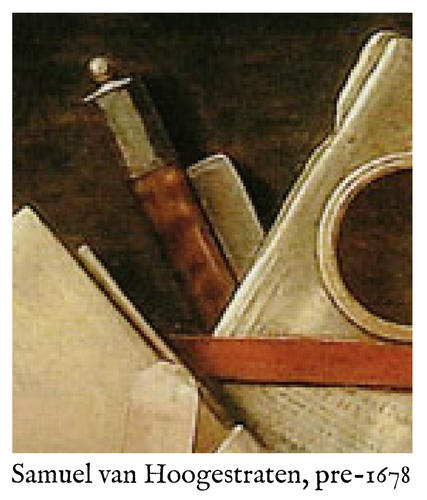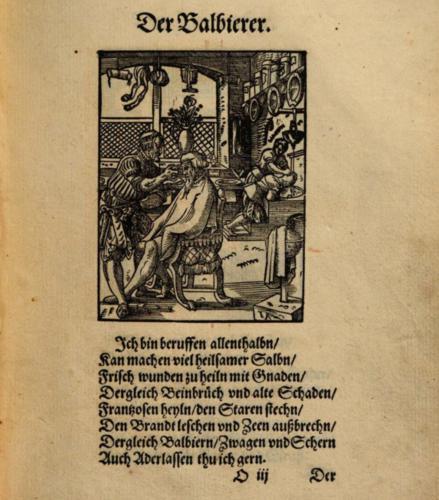Results 1 to 10 of 26
-
09-22-2016, 06:21 PM #1
 17th century straight razors - artistic depictions
17th century straight razors - artistic depictions
I'd been wondering what the average razor from the 1600s looked like, and it turns out there are actually a lot of sources for images of them. Some are from manufacturers' trade cards (which can be a bit caricatured), some are from various engravings or other artworks, some are from high-realism paintings. I've assembled a few here going by date to give an idea of the appearance of these things. Some of the dates of the trade cards have been corroborated from "Antique Medical Instruments" by Elisabeth Bennion, University of California Press, 1979. If anyone has corrections to any of the information here or has more to add, please do so.
Caveats to these images:
1. They are artists' impressions, so features can be distorted or exaggerated.
2. They are from different geographical regions, so strong differences in style could be present. The trade cards are mostly from cutlers based in London. The realistic paintings are generally Dutch, but that doesn't necessitate that the razors in those images are also Dutch.
The first is from John Woodall's "The Surgions Mate", from 1617. There are two images from this selection of the large panel of instruments - the top one, with number 3, is described as a razor, while the bottom, number 2, is described as a 'dismembering knife' to cut the fleshy bits prior to sawing bone in an amputation. There is also some text that goes along with the razor.


The 2nd edition of the book was published in 1639 and offers the following engraving. Without a copy of that book to cross-reference the image though, I'm not sure if this is another example of a razor or some other kind of knife:

This next one comes from 1668 by Cornelius Gijsbrechts of the Dutch school, from a highly realistic painting. The razor sits in its case, highlighting the way it was stored and the coloring of the inside of the case:

Another painting by Isaak Koedijk (dating before his death in 1668) shows a similar case, with more spots for tools and implements, in a similar color scheme:

Dating before 1670, a painting shows razors hanging in the workplace of a barber-surgeon:

Also Dutch and dating before 1678 are two depictions by Samuel van Hoogestraten of tortoiseshell-scaled razors with silver endcaps:


In the range of 1680-1710 are some trade cards that give impressions of razors of the time:




In the same range (before 1704), works associated with Cornelius Dusart offer a few more depictions:



-
The Following 18 Users Say Thank You to ScienceGuy For This Useful Post:
32t (09-23-2016), BobH (01-23-2017), celticcrusader (01-28-2017), CortoPT (04-04-2018), dinnermint (09-22-2016), engine46 (09-23-2016), Geezer (09-22-2016), Grazor (09-22-2016), Hanlon (04-09-2018), karlej (09-27-2016), manah (01-23-2017), Martin103 (09-23-2016), MisterClean (04-04-2018), outback (04-04-2018), RezDog (09-04-2019), rolodave (01-23-2017), tinkersd (01-26-2017), tintin (01-24-2017)
-
09-22-2016, 06:26 PM #2

Here's a real one, I think posted elsewhere on SRP but putting it here for completeness.

-
The Following 12 Users Say Thank You to ScienceGuy For This Useful Post:
-
09-24-2016, 11:57 PM #3

More, this time from barbers' bowls.
c. 1720:

1706:

1681:

1700-1720:

c. 1750:

early 1700s:

c. 1700:

1701-1750:

c. 1710:

-
The Following 11 Users Say Thank You to ScienceGuy For This Useful Post:
-
01-23-2017, 10:09 PM #4Historically Inquisitive



- Join Date
- Aug 2011
- Location
- Upstate New York
- Posts
- 5,782
- Blog Entries
- 1
Thanked: 4249
16th Century woodcut by Jost Amman 1539-1591. Barber/surgeon, you can see the bowl and razor in the background. Woodcut is a technique of carving wood to use to illustrate books in that time period.


-
The Following User Says Thank You to Martin103 For This Useful Post:
MisterClean (04-04-2018)
-
01-23-2017, 10:20 PM #5

I had tried reading the text that accompanied this woodcut. It's in an old form of German, so was difficult to make out, but I gave up after pages and pages of biblical and religious rambling.
The knife pictured could be a shaving razor, a surgical knife, or a dual-purpose for both functions. I'm not sure which it is.
-
01-24-2017, 12:10 AM #6

interesting, what is the purpose for the barbers bowls especially the cut out in the rim? shaving or bloodletting?
-
01-24-2017, 02:10 AM #7

@ScienceGuy: if you are interested in a translation of the text please post it and I'll try my hand at it.
Plus ça change, plus c'est la même chose. Jean-Baptiste Alphonse Karr.
-
01-24-2017, 03:08 AM #8

Now I can't find the book that I was referencing. (The illustration appears in a number of books). I did find this one though. From "Eygentliche Beschreibung Aller Stände", Hans Sachs, Frankfurt, 1568.
Translation (I kept it as literal as possible, hope I got everything correct):
The Barber [Balbierer/Barbierer = barber(surgeon)]
I am qualified all-around,
Can make many salubrious salves,
Fresh wounds to heal with grace,
Similarly leg fractures and old damages,
French healing/piercing to relieve cataracts,
Burn healing and removing the teeth,
Similarly barbering, Zwagen [a bathing process] and shaving,
And bloodletting I do happily.

-
The Following User Says Thank You to ScienceGuy For This Useful Post:
MisterClean (04-04-2018)
-
01-24-2017, 03:30 AM #9

Maybe you can find something useful in the section on De Scheermessemaker? Link here, pg. 235: https://books.google.com/books?id=Zc...emaker&f=false
-
01-24-2017, 04:36 PM #10

It is basically a description of the trade of a barber in the past. Gothic writing is difficult for me to decypher.
The gist: The Barber. He can make ointments, heal broken bones and wounds, cut cataracts. And of course he is a barber. He can wash and shave. And I like to perform a phlebotomy.Plus ça change, plus c'est la même chose. Jean-Baptiste Alphonse Karr.
-
The Following 4 Users Say Thank You to Kees For This Useful Post:
CortoPT (04-04-2018), MisterClean (04-04-2018), outback (04-04-2018), ScienceGuy (01-24-2017)


 145Likes
145Likes LinkBack URL
LinkBack URL About LinkBacks
About LinkBacks






 Reply With Quote
Reply With Quote

